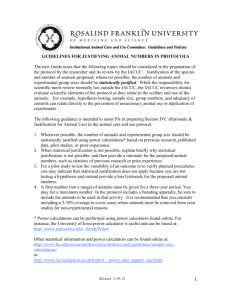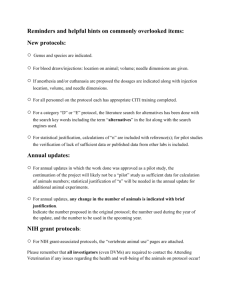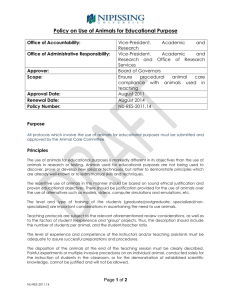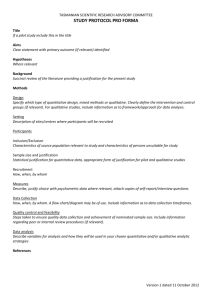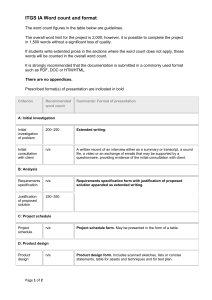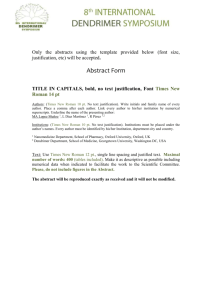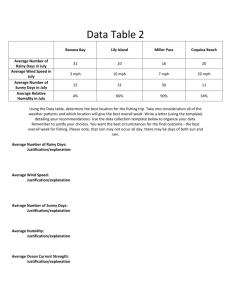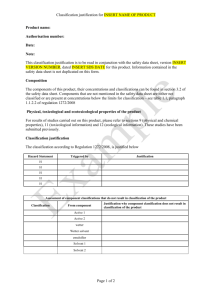AnimalNumbersJustification
advertisement
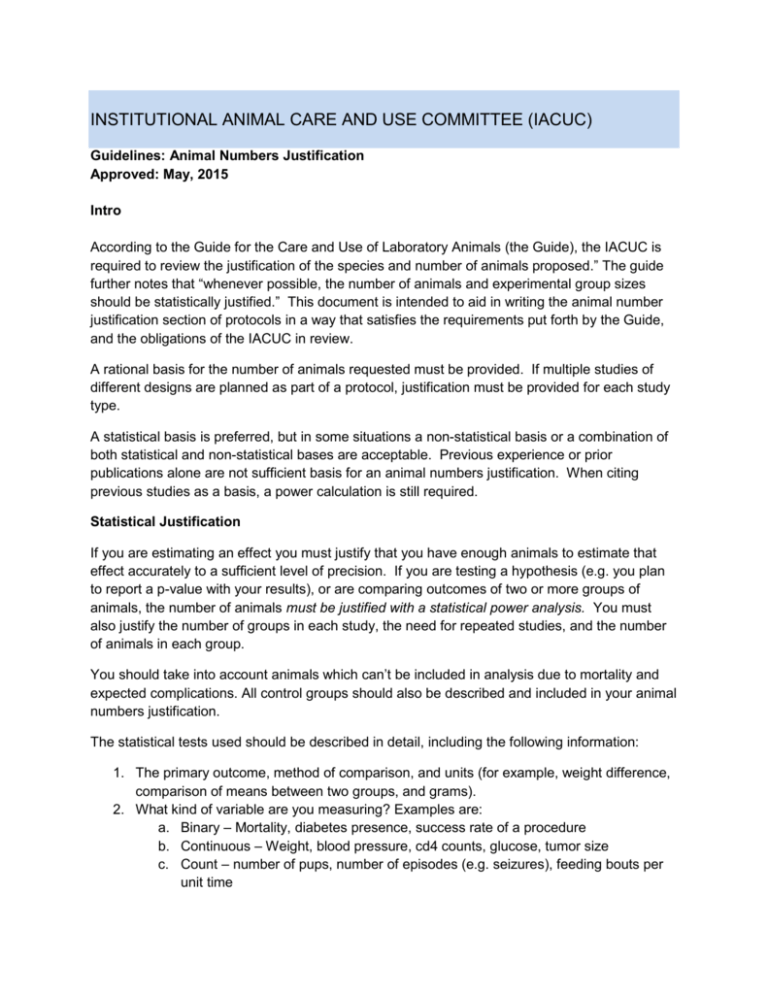
INSTITUTIONAL ANIMAL CARE AND USE COMMITTEE (IACUC) Guidelines: Animal Numbers Justification Approved: May, 2015 Intro According to the Guide for the Care and Use of Laboratory Animals (the Guide), the IACUC is required to review the justification of the species and number of animals proposed.” The guide further notes that “whenever possible, the number of animals and experimental group sizes should be statistically justified.” This document is intended to aid in writing the animal number justification section of protocols in a way that satisfies the requirements put forth by the Guide, and the obligations of the IACUC in review. A rational basis for the number of animals requested must be provided. If multiple studies of different designs are planned as part of a protocol, justification must be provided for each study type. A statistical basis is preferred, but in some situations a non-statistical basis or a combination of both statistical and non-statistical bases are acceptable. Previous experience or prior publications alone are not sufficient basis for an animal numbers justification. When citing previous studies as a basis, a power calculation is still required. Statistical Justification If you are estimating an effect you must justify that you have enough animals to estimate that effect accurately to a sufficient level of precision. If you are testing a hypothesis (e.g. you plan to report a p-value with your results), or are comparing outcomes of two or more groups of animals, the number of animals must be justified with a statistical power analysis. You must also justify the number of groups in each study, the need for repeated studies, and the number of animals in each group. You should take into account animals which can’t be included in analysis due to mortality and expected complications. All control groups should also be described and included in your animal numbers justification. The statistical tests used should be described in detail, including the following information: 1. The primary outcome, method of comparison, and units (for example, weight difference, comparison of means between two groups, and grams). 2. What kind of variable are you measuring? Examples are: a. Binary – Mortality, diabetes presence, success rate of a procedure b. Continuous – Weight, blood pressure, cd4 counts, glucose, tumor size c. Count – number of pups, number of episodes (e.g. seizures), feeding bouts per unit time 3. 4. 5. 6. d. Ordinal – an order or progression, such as tumor size at time A versus time B The p-value (i.e. the alpha level) you consider significant. The expected variation within a group of animals treated the same way (Assume different variance between study groups unless there is a reason to presume otherwise). The effect size (the smallest difference between groups that you want to find or you would consider meaningful, e.g. 20% change in the units of the primary outcome. Note: very small effects requires very large numbers of animals). The statistical power you are trying to achieve (one minus the probability of failing to reject the null hypothesis when it is false). Pilot Studies Pilot Studies are generally less certain, however, that does not exempt them from the statistical justification requirement. In writing a statistical justification for a pilot study, an investigator should perform the same type of analysis as above using estimation for factors such as variance, effect size, and statistical power. Repeated Studies The IACUC recognizes that some publications consider or require the reproducibility of studies in their acceptance criteria, however, according to the guide the IACUC is specifically required to review protocols for “unnecessary duplication of experiments.” As such, protocols including repeated studies should include additional justification on the value of duplicating the experiments, and should take care to ensure that their statistical justification and power analysis are sufficient for multiple experiments, as opposed to a single study with a larger sample size. Breeding The selecting of animals for traits, genes, phenotypes, etc. is common in animal research. Obtaining a sufficient number of animals with a specific genetic trait often involves breeding. In this portion of the animal numbers justification, describe the numbers of breeding animals based on factors such as the number of genes of interest, homozygosity/heterozygosity of breeders, viability of homozygotes, whether both sexes can be used, and whether wild-type siblings are used as controls. The number of animals you expect to need, as well as expect to produce should be included in the animal numbers justification. If you are conducting breeding with experimental protocol, the breeding number justification should be separate from the justification required for hypothesis testing. When a Non-statistical Justification Should be Included In some situations, animal numbers are justified in full or in part on a non-statistical basis. If you are not hypothesis testing, animal numbers must still be justified and based on a non-statistical basis. Examples of non-statistical Justification: Training: The number should be based the number of individuals to be trained, and the difficulty of whatever individuals are being trained in. Feasibility Studies: Often can sometimes be considered an n=1 study, in order to see if, for example, a procedure is feasible. Antibody/Tissue Production: The numbers should be based on the amount of material (tissue, blood, etc.) needed for the study.
